When in Amsterdam you now have the incredible choice of three Rembrandt experiences led by Drs Kaldenbach:
1) Some of the best and grandest real Rembrandt paintings in the world, shown in the Amsterdam Rijksmuseum.
2) Experiencing Rembrandthuis, the home he lived and worked in, with paintings and numerous etchings.
3) Seeing all 330 paintings in the Magna Plaze building behind the Royal Palace/Town Hall
Menu of tours
In the shopping center Magna Plaza just behind the Royal Palace on Dam square a VERY good exhibition has been realized of all 330 Rembrandt paintings reproduced in full size. This is a serious set-up. Well organized, well captioned. Well lit, well presented. I fully encourage art lovers to take this full immersion dive into Rembrandt's world.
The very best digital and analog image sources have been gathered in museums all over the world. Then all images went through digital remastering and post-production, to take away possible pigment discoloration that has occurred and other detrimental effects like glare and varnish yellowing that may have occurred.
This is a SERIOUS presentation. Scientific research has been done during the last decades by professor Ernst van de Wetering, lifetime member of the official Rembrandt Research project. This reproduction show is the grand presentation of knowledge gathered throughout the process.
Well worth the normal price of E 14.50 to see all 330 paintings in the Magna Plaze building behind the Royal Palace/Town Hall, Amsterdam.
Web site in http://www.rembrandtallhispaintings.com/en/
Dutch http://www.rembrandtallhispaintings.com
Seeing this exhibition on your own is of course an option. An even better experience is awaiting you when you visit this exhibition with your personal art historian. We will discuss meaning, composition, colour, size, workshop practices, fashion, canvas size, possible cropping etc.
A presentation of just before the opening week after the 10 year museum restoration by Andrew Graham-Dixon. I was there on-camera with my daughter and we were filmed, but in the final edit - alas - we did not make it in the documentary.
Above: image of the exhibition space. In this image my camera has caused glare and uneven light effects. However, when normally seen with the human eye the result is far more natural and satisfactory. The human eye has great adaptability for colour and intensity of light.
Master of light, master of communicating emotion
Rembrandt has mastered an uncanny way of transmitting feelings and human experience. he is probably one of the best to have found a way to plug into the human heart ans soul. Good examples is the painting of biblical scenes.
He is also a man that has turned against the rules of normal society. Not paying bills, not paying rent, making fights with the high and mighty.
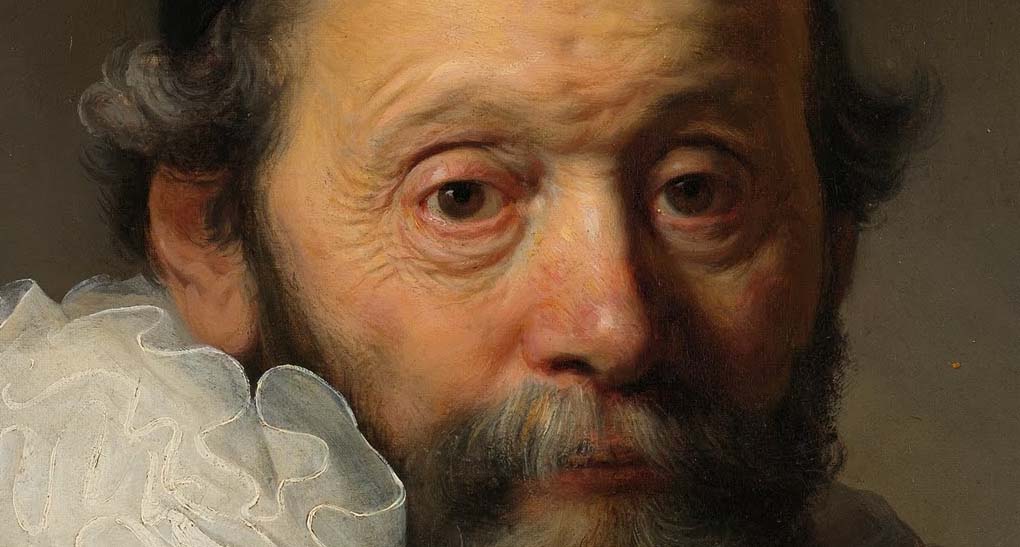
When in amsterdam you have the incredible choice of three Rembrandt experiences:
1) Some of the best and grandest real Rembrandt paintings in the Rijksmuseum.
2) Experiencing the home he lived and worked in, with some great paintings and numerous etchings.
3) Seeing all 330 paintings in the Magna Plaza building behind the Royal Palace/Town Hall
Rijksmuseum tour. The glorious national collection.
Sneak Preview Rijksmuseum reopens
Vermeer lectures and tours.
See Dali's opinion of Vermeer.
Vermeer and Neuroscience / Opthalmology.
Rembrandt tours incl the Maria Trip portrait.
English article on key portrait of Uytenboogaard.
Dutch/NL text Uytenboogaerd, Dutch .
See all 330 Rembrandt paintings in full size reproductions, in about 2 hours in the Magna Plaza building behind the Royal Palace/Town Hall
Clipping from the NYT, copyright NYT. In this particular case I was not asked to be the tour guide!
In the middle: daughter Suzanne, who has not been there 12 years, Kees Kaldenbach and interviewer Andrew Graham-Dixon.
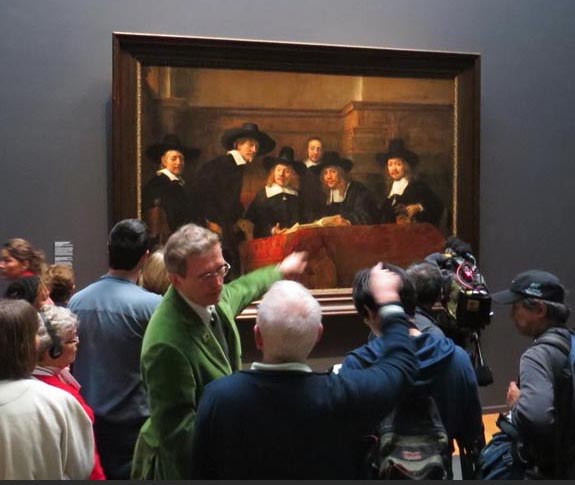
April 2013: Presentation for Japanese TV in the Rijksmseum. We can also go there to see the real thing.
Would you like to enter the Rijksmuseum at exactly 9 AM, bypassing all waiting lines and standing in a virtually empty museum ? Ask me to be your guide!
More Rembrandt pages:
Portrait of hippie preacher Uttenboogaard
Fancy portrait of Maria Trip
Rembrandt lectures in the home of art historian Kaldenbach
1) The real thing in the Rijksmuseum.
Nothing beats standing face to face in front of a real REMBRANDT and viewing the real thing. Amsterdam is a fine place to do so because here we have the Rijksmuseum (State museum of art) and the Rembrandt House, the place where he actually lived and worked for many years.
Although leafing through illustrations in art books and images on the Internet are fabulous for study purposes, and indispensable in order to learn how to distinguish and compare, understand and classify, there is one experience paramount.
Standing face to face with an actual painting by Rembrandt or an actual etching by Rembrandt may become a thrilling and moving event.
The Rijksmuseum is the prime place for viewing paintings in Holland, although the collections in museums in The Hague (Mauritshuis) and Rotterdam (Boijmans) are a good alternative.
The paint surface: is it shiny and glassy-translucent like a Russian lacquer box (this is the successful style he invented and taught, called fijnschilderkunst or fine painting) or is it as rough and unkempt like bricklaying mortar? Did he succeed in combining both techniques within one and the same painting, like in the stunning Prophet Jeremiah lamenting the sacking of the temple in the Rijksmuseum.
Did he only use the fine style in the beginning of his career, and the rough style only later on, or did he move to and fro with those techniques throughout his life?
And what is the psychological wizardry and soul-searching he employes, even at a young age, as a young man of barely 22 or 24? What did Rembrandt write on that subject...? In a letter to Constantijn Huygens, the art lover and Secretary of State, Rembrandt used the term 'naetuereelste beweechgelikheijt'; would a translation in 'Most natural movement' be called for or are there other options for translation? If so, what does this imply?
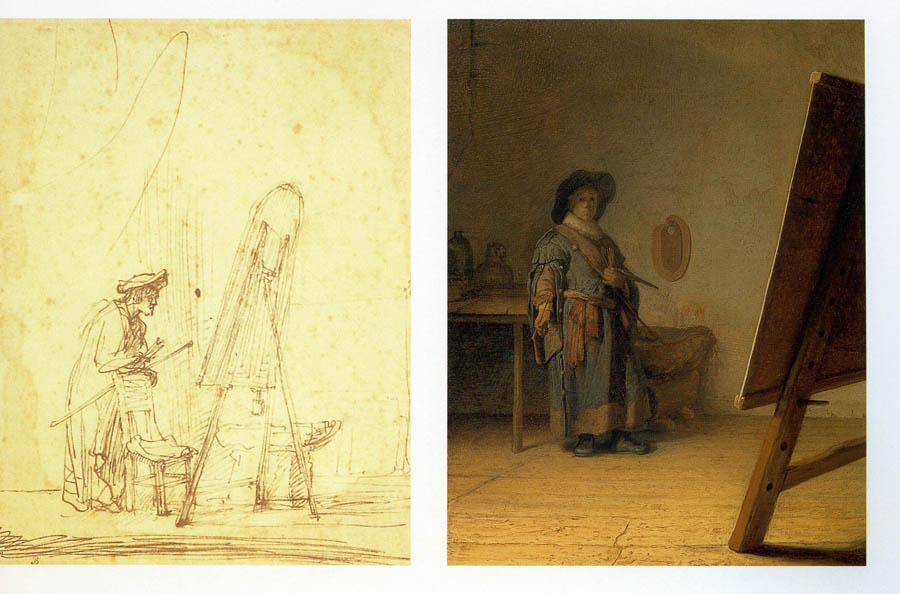
Rembrandt and Lievens probably shared a studio in Leiden. This is the interior.
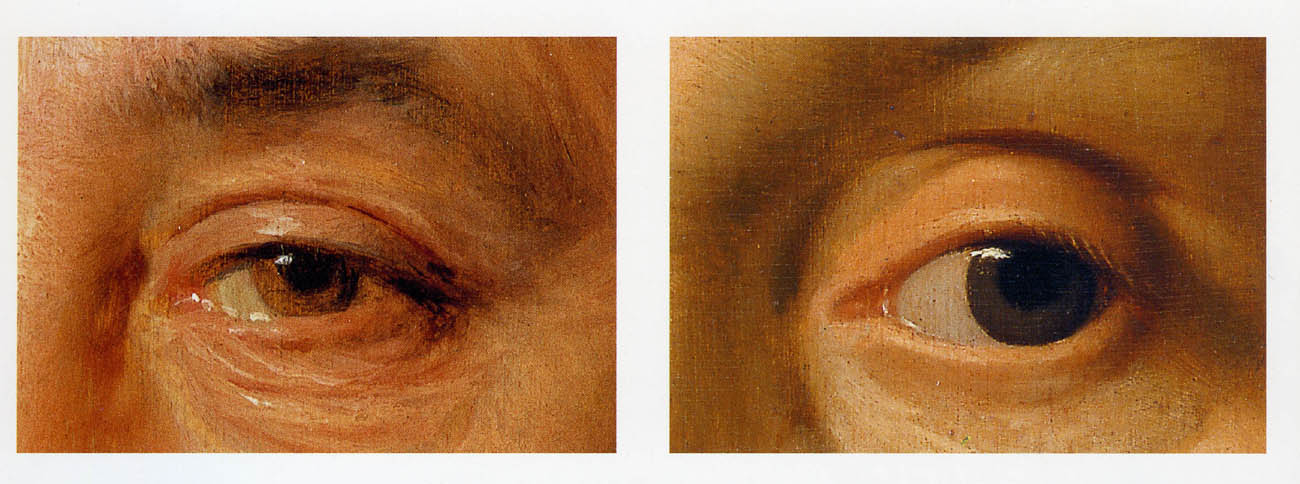
Expressive qualities in the art of painting: an eye painted by Rembrandt (to the left) . . . . . . . . and an eye by the head man of the St Luke Guild, Pickenoy (to the right)
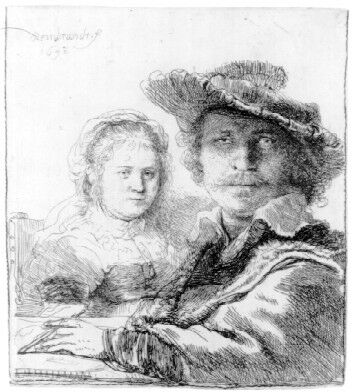
Saskia and Rembrandt, their good years. Etching. Rembrandt belongs to the class of best etchers in teh world. On show in the Rembrandthuis.
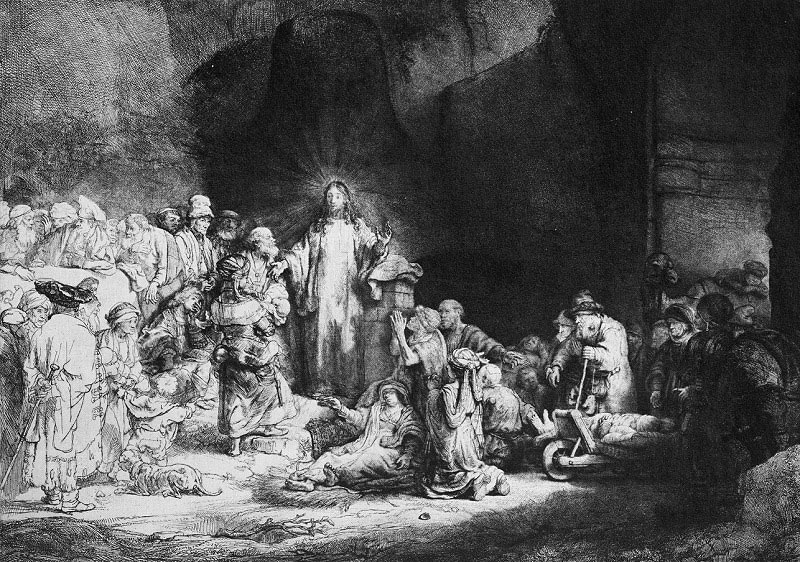
The Hundred Guilders Print, as an etching unfinished (according to Prof. Ernst van de Wetering) but nevertheless driven to extremely high cost in on auctions in Rembrandt's time.
Rembrandt House
And then over to the Rembrandthuis. the house in which he lived with Saskia and in which his children were born. The interior has been re-constituted based on the inventory list of his bankruptcy. It feels like walking into his studio and sale rooms, as if the great master has just walked out on doing some business and left you there to roam about on your own. On the top floor one can stand face to face with a good series of the actual etchings.
What sets Rembrandt apart from other artists like Duerer, Lucas van Leiden, Elsheimer? How fine or bold are Rembrandts results in the etching and engraving lines? Learn how to see and appreciate how he employed these fine or bold lines in the etching and engraving in order to get the 'Most natural movement'?
A bit of social history and the personal history will also serve to put Rembrandt in perspective. Was he really a cantankerous man who alienated the wealthy patrons after 1642, the year of the Nightwatch?
I will be there to assist you in viewing and I will help you to hone your own way of seeing. Art appreciation in front of the real thing.
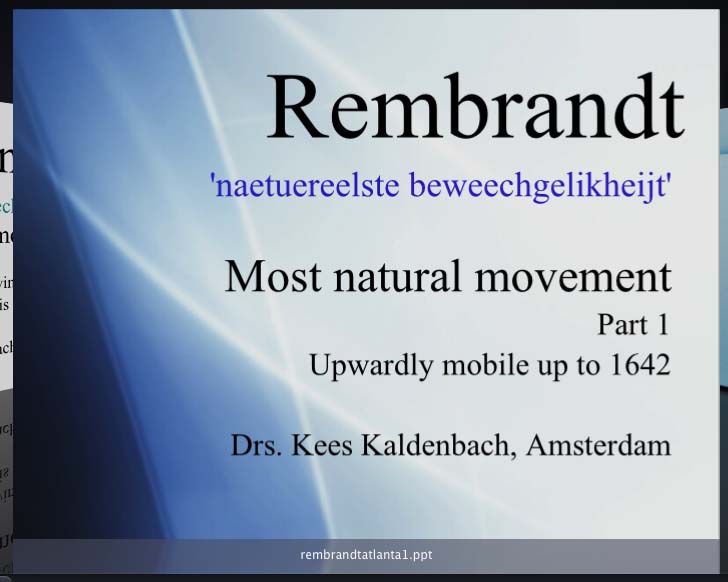
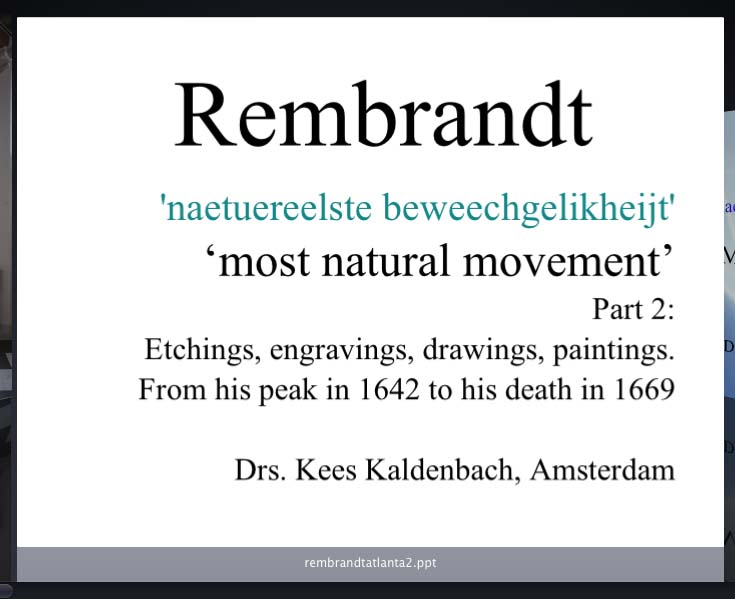
I am prepared to give this set of two powerpoint presentation lectures. A while back, I presented it at Atlanta, Georgia, at the Oglethorpe University.
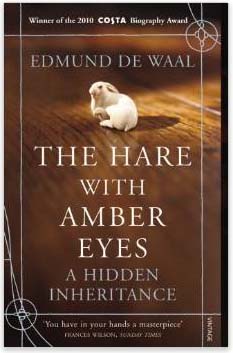 ..
..
From: Edmund de Waal, The Hare with Amber Eyes, A Hidden Inheritance, 2011.

Art historian Drs. Kees Kaldenbach lives and works in Amsterdam and is specialized in European art. As a teacher and public educator he uses lectures and multimedia technology to present a rich tapestry of image information on European art history both for the public at large and for fellow art historians.
Drs Kaldenbach has published widely and has designed a major 2000+ item web site on the art of Johannes Vermeer and other Delft artists. He has collaborated in fine art TV programs by networks such as CNN, BBC2, BBC3. He has also published books and many articles on art, some on Rembrandt.
He has a great capacity to share with others his deep passion for art history while sharing ways of heightened perception.
Experience the famous Rembrandt paintings in Amsterdam, Holland in a new light! This is a fine way to celebrate the aftermath of Rembrandt's 400th birthday.
Imagine being the privileged guest of honour at the home of art historian Kees Kaldenbach. While sipping a fragrant cup of coffee or tea, you listen to a personalized (private or small-group) lecture and discussion on the astounding visual wonders that Rembrandt has bestowed upon us.
Afterwards, a short ride in my private car or by tram takes us to the nearby Rijksmuseum (additional entry fee). In the museum I will point out and explain the visual wonders of Rembrandt's technique; contents, brushstrokes, details, composition, colour.
You may also arrange this VIP treatment for business contacts or friends. This cultural organisation office will take care of a memorable experience. Lectures (in Dutch, English or German + translations into Japanese) are given in plain, accessible language. Thus you will be the beneficiary of tailor made scholar lectures* during your travels.
Click for Nederlands/Dutch.
Rembrandt lectures in Public speaking engagements Atlanta, Georgia, 2007.
In 2008 Drs Kees Kaldenbach published his museum guide on paintings by Rembrandt. Pubisher: Scriptio.
Drs. Kees Kaldenbach will be your private "scholar-lecturer on culture tours".*
*Martha Gellhorn, Travels with Myself and another, page 182.
It is a rare and unique privilege that the Rijksmuseum has linked from the main Rijksmuseum site to my site. Start at www.rijksmuseum.nl and select Collection, after which you choose Digital Collaboration and the Digital Vermeer House.
Drs. Kaldenbach is chairman of the Circle of Academic Tour Guides of the Netherlands and Flanders (CATON)
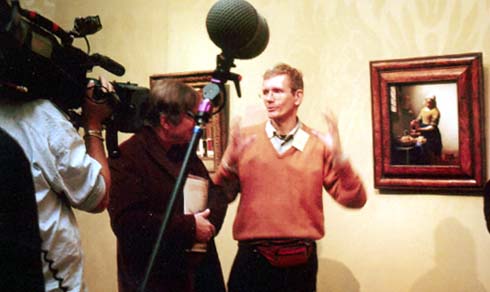 Read client referrals and testimonials.
Read client referrals and testimonials.
Spotting the Rich & Famous inhabitants in the Golden Age

Optional added items
Chauffeur driven sightseeing (perhaps for a visit on another day) is possible to these venues:
a) the Rembrandt House, Amsterdam, for an in-deph guided tour.
b) the 330 paintings in the Magna Plaza building
c) the Rembrandt City Walk and Public speaking engagements
d) the Royal Collection The Mauritshuis Museum in The Hague, which houses several renowned Rembrandt paintings, including his 'Anatomical Lesson of Dr Tulp'. Vermeer paintings may also be discussed there.
You will either be driven in the car of Mr. Kaldenbach, seating up to 3 to 4 passengers) or in a minibus (seating 4 up to 8 passengers). The minibus will probably be driven by Mr Hans who is both a geography teacher and a qualified taxi driver. During the ride he will be able to tell you fascinating details about landscape and human habitation.
Practical matters
Time in museum: over 1 hour. Optional time walking outside following Rembrands trail.
Read a biography.
Research presented in November 2014 about the Amsterdam art collector Mannheimer: he almost bought the best Vermeer: The Art of Painting (now in Vienna)
About Art Historian Drs. Kees Kaldenbach:
Read a biography.
In July 2004 he was interviewed about Delft artists by Tetsuya Tsuruhara for the leading Japanese newspaper The Yomiuri Shimbun. In 2004 and 2005 he acted in an advisory role to additional BBC2 teams. Kaldenbach has written extensively on Vermeer and 17th century Delft, on Van Gogh and on other art history topics. Drs. Kees Kaldenbach will be your private "scholar-lecturer on culture tours".
It is a rare and unique privilege that the Rijksmuseum has linked from the main Rijksmuseum site to this site. Start at www.rijksmuseum.nl and select Collection, after which you choose Digital Collaboration and the Digital Vermeer House.
Further information is available on the web site: www.johannesvermeer.info
Photo by Dick Martin.
Reaction, questions? Read client testimonials.
Drs. Kees Kaldenbach, art historian, kalden@xs4all.nl Haarlemmermeerstraat 83hs, 1058 JS Amsterdam (near Surinameplein, ring road exit s106, streetcar tram 1 and 17).
Telephone 020 669 8119; cell phone 06 - 2868 9775.
Open seven days a week.
Amsterdam Chamber of Commerce (Kamer van Koophandel) number of Johannesvermeer.info / Lichaam & Ziel [ Body & Soul] is 3419 6612.
E mail esponses and bookings to art historian Drs. Kees Kaldenbach.
This page forms part of the 2000+ item Vermeer web site at www.xs4all.nl/~kalden
Updated June 9, 2016. Updated 19 january 2017.